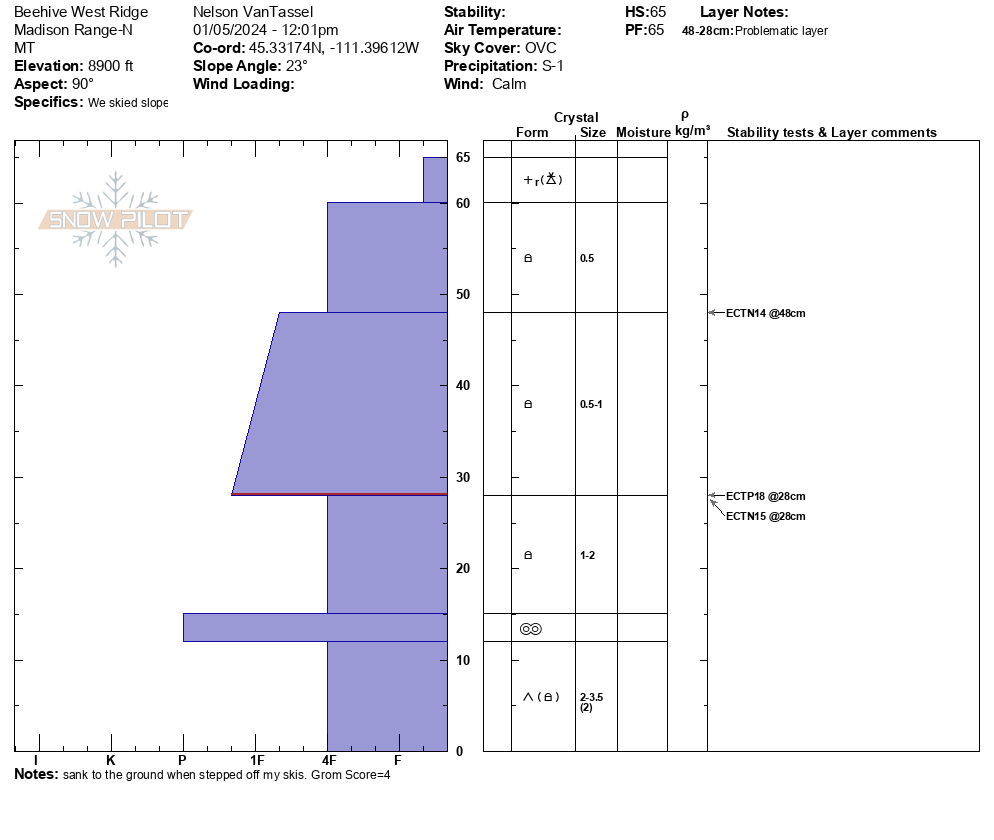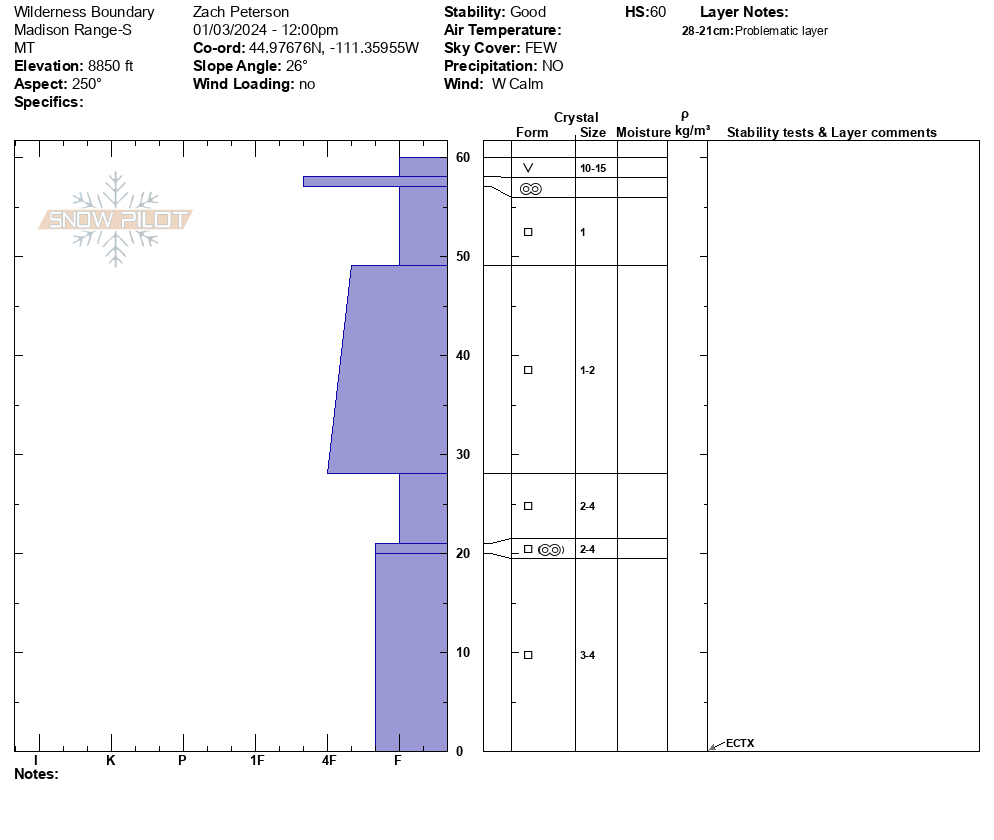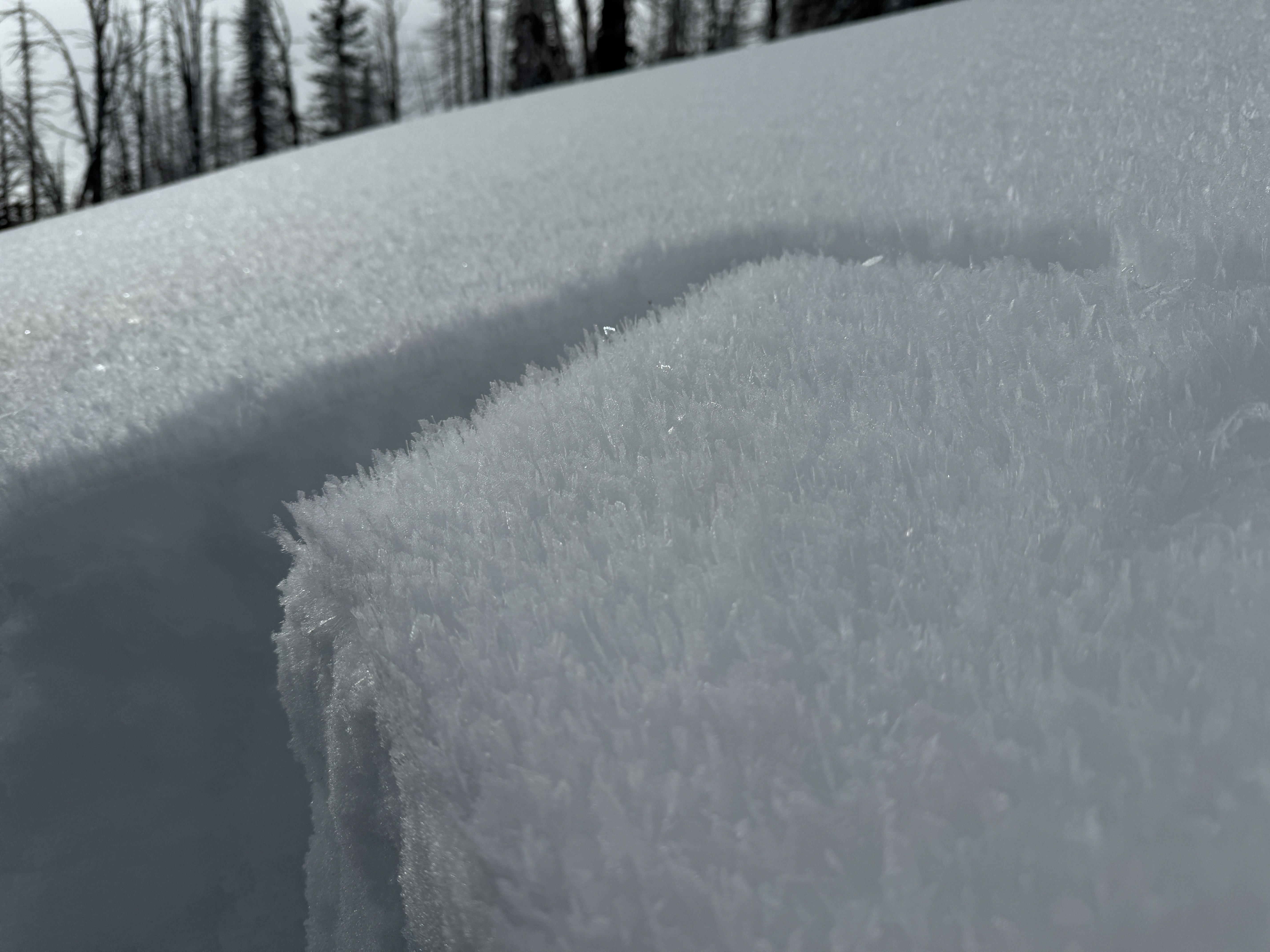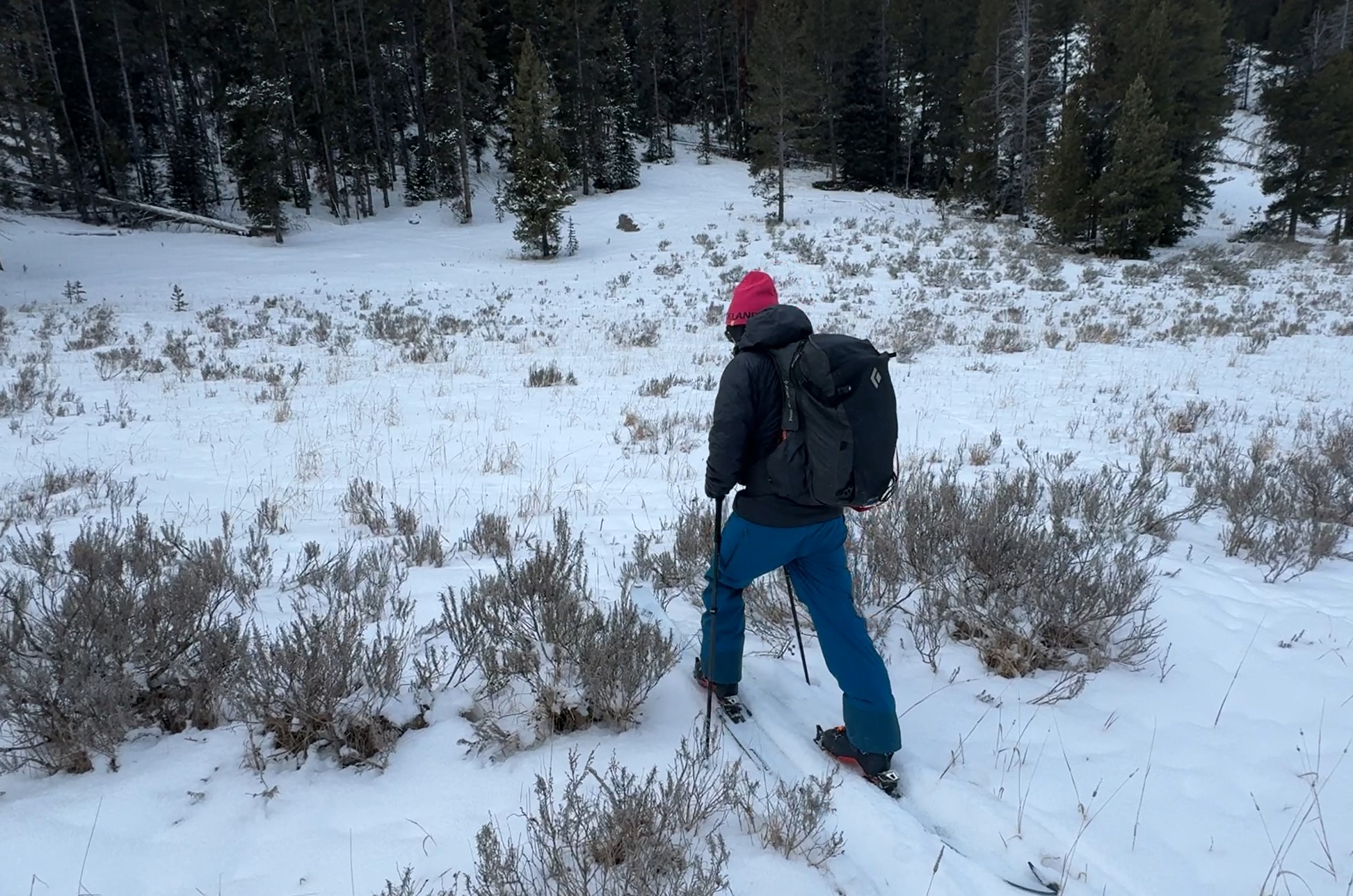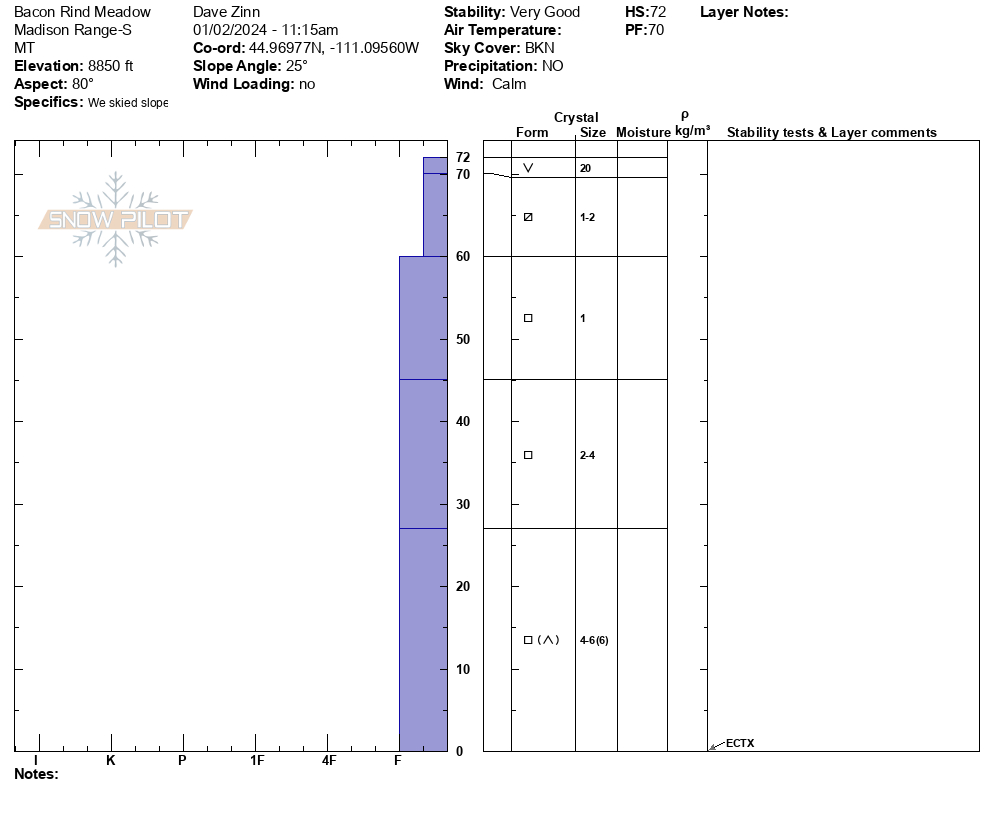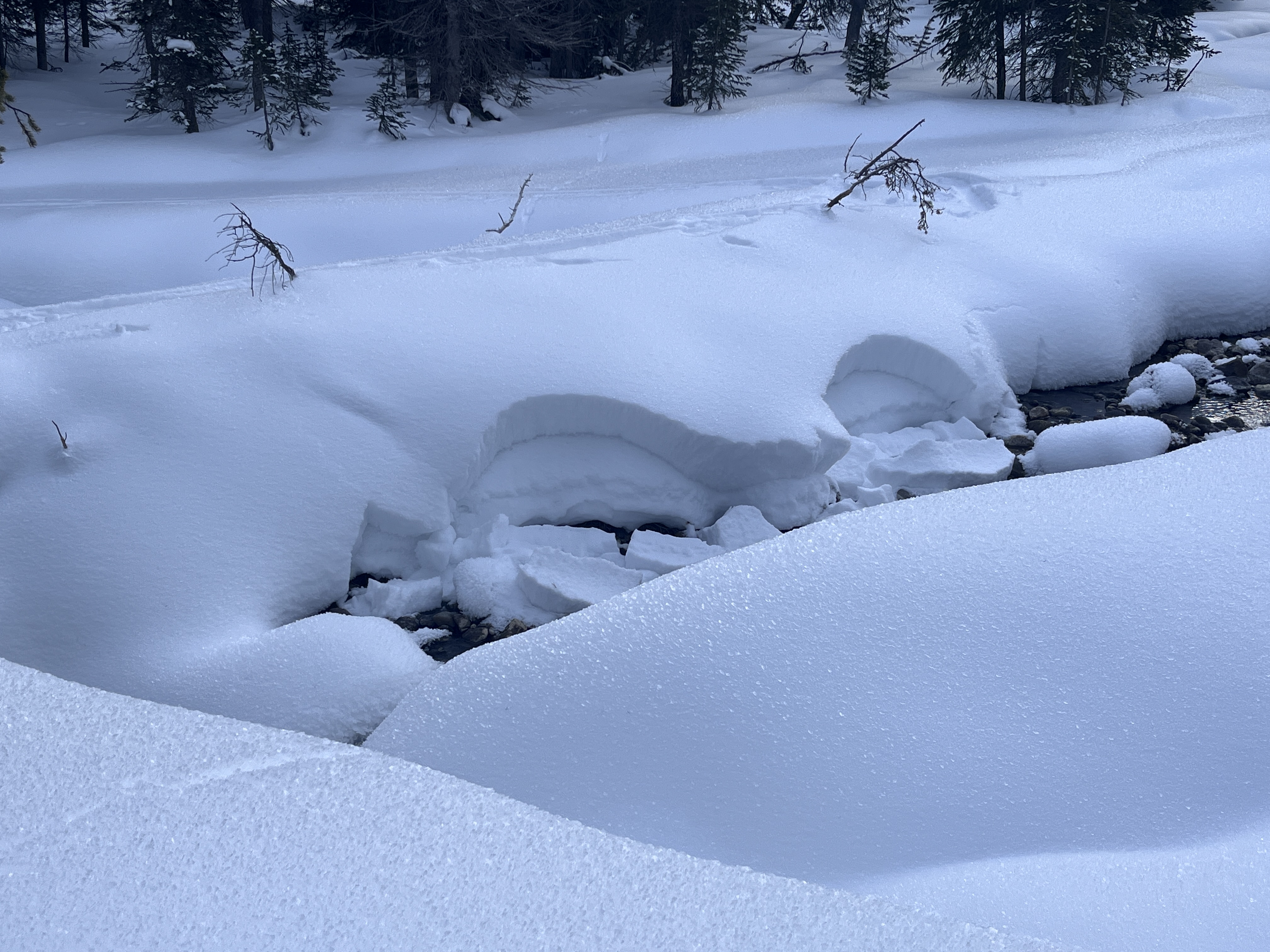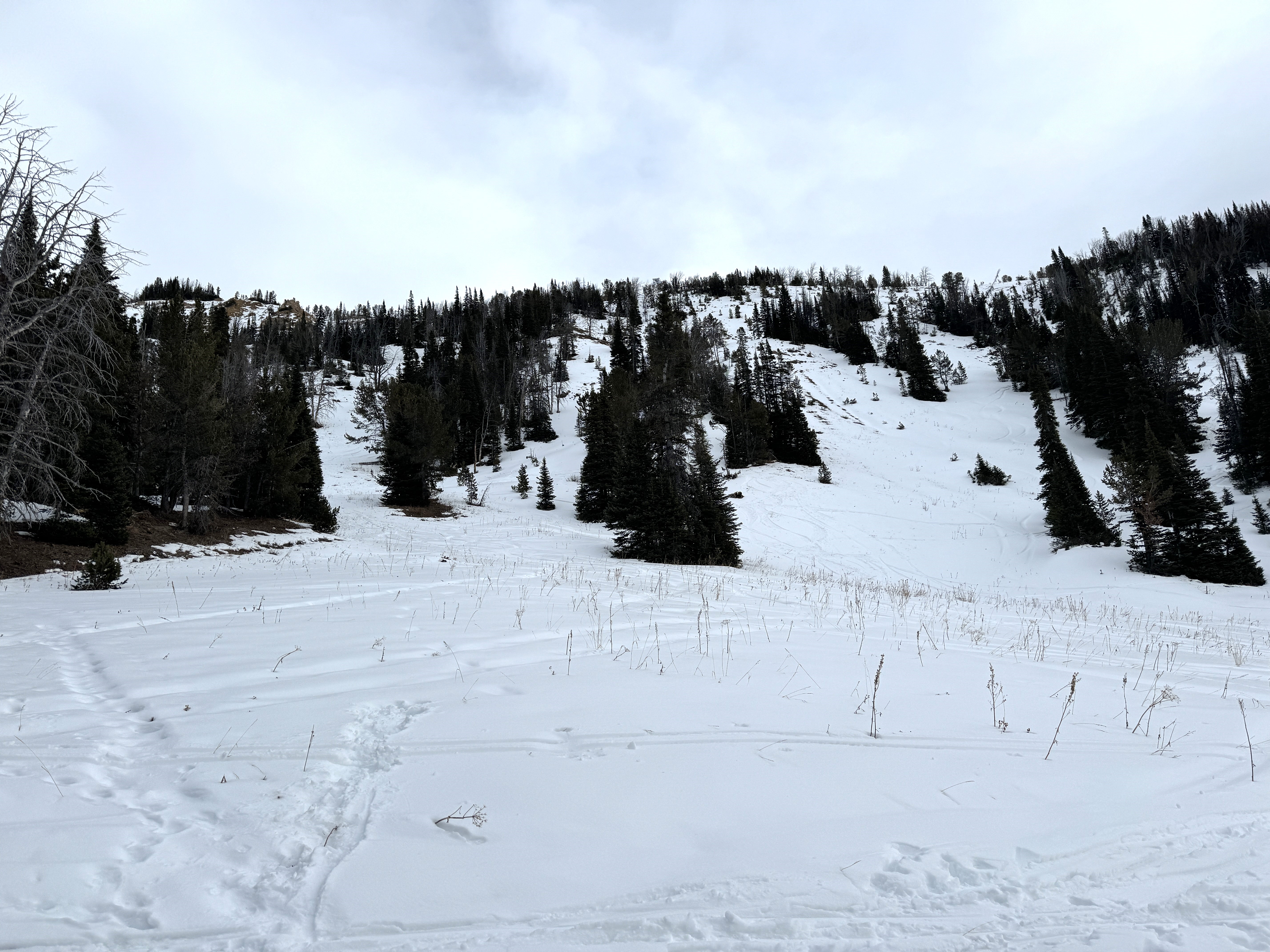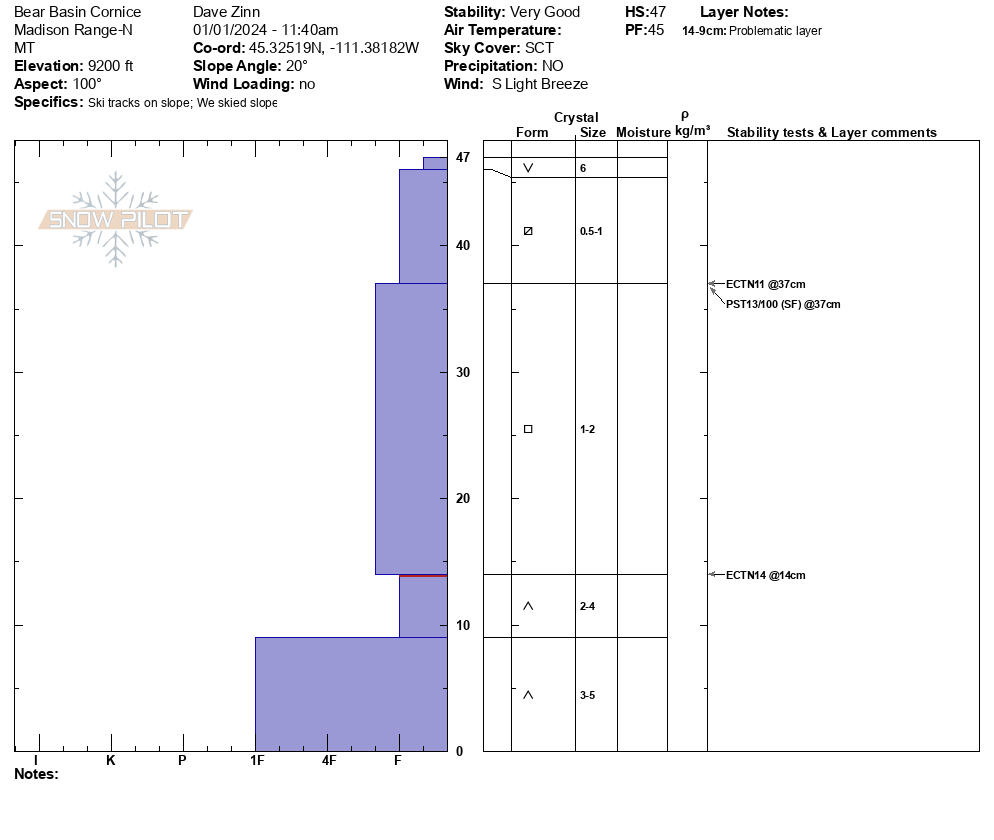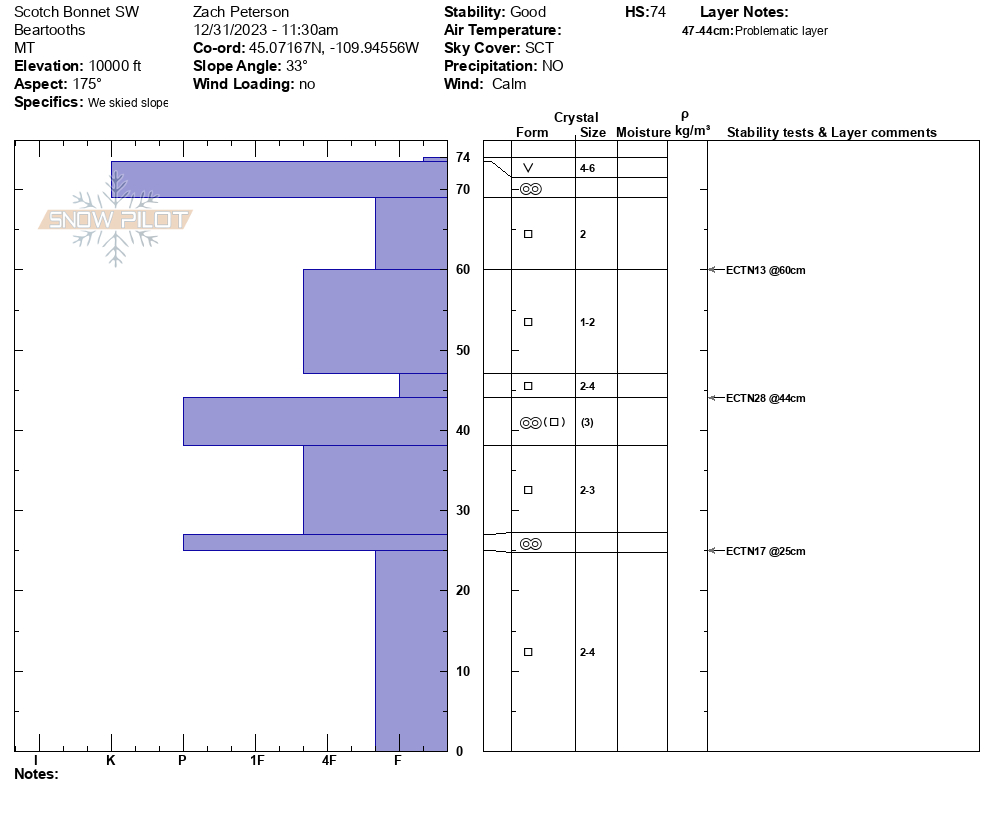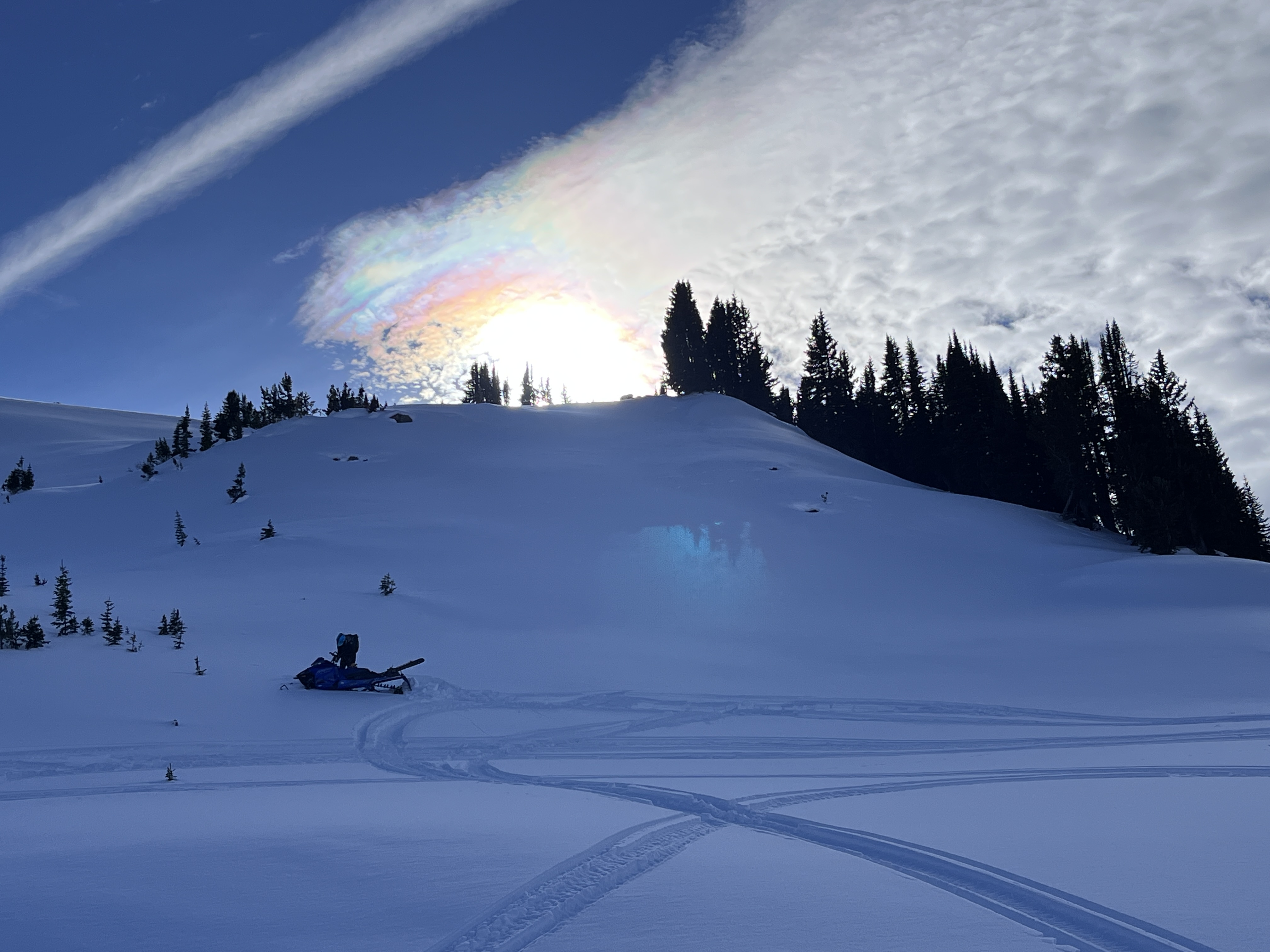Snow Observations List
No new/different signs of instability in the snow pack from the forecast or observing other skiers and poking around in the basin. Snow pack is between 1-2 feet from trail head to 9200 ft, 95% faceted and the rest surface hore or the trace of new snow. The pack is 100% rotten. With no slabs there wasn’t any propagating but with a heavy ski cut two of the point releases were triggered and the third when skiing. All three went to the ground. All triggered after the first skier made no impact on the slope, no visual signs or “poor” test results. A reminder how poor the snow structure is this year.
Full Snow Observation ReportGusty winds were transporting snow into drifts that formed cohesive wind slabs. Variable snow condition with a notable sun crust under the drifted snow (45.44653, -110.99872). Witnessed a dry slab natural avalanche start from near the summit of Blackmore mountain that ran into the main bowl. Multiple other observations of small loose avalanche activity on Blackmore mountain. The trail out was exceptionally rocky.
Full Snow Observation ReportFrom email: "Made it to the ridge of Hyalite peak yesterday. Mild winds ~10mph at around 1pm. Seemed to be ~6" of fresh snow in the basin. No instabilities in our pit at 9300ft; fist hardness throughout. 85cm depth. Great skiing in the basin. Off the ridge, it was a little firmer with a wind crust. There was a small natural wind slab avalanche on an east aspect a few hundred feet SW of the saddle."
Full Snow Observation ReportObservations and an old natural avalanche from a skier on 01/05.
Full Snow Observation ReportHey y'all! Not sure if this has been sent into y'all or not but thought I'd send it your way. Didn't get up to it, I'd guess a couple days old? At first I thought wet slide but then looking at the trees to the left I thought maybe it was a small crown? None the less enjoy! It's just up Basin from hidden gem on the sameish aspect.
Full Snow Observation ReportToured out to the playground and found isolated areas of instabilities. Some areas out of the trees had shallow 1-3 inch thick slabs which failed on isolation in quick hand pits but did not appear to propagate in ECTs. No shooting cracks or big collapses were observed. The good skiing in the tress would probably improve Doug's Attitude.
Full Snow Observation ReportSurface Hoar all over including just below the new dusting of snow. Test on a northeasterly facing slope at 8000ft, had an ECT N at about 20 hits. It failed on a crust approx 10-15cm off the ground.
Full Snow Observation ReportWe were the first to arrive at the bottom of Lulu Pass this morning and observed 3 natural avalanches on E and NE aspects of Henderson Mountain. The turn off from HWY 212 towards Lulu pass had received 4-6in of low density snow the night before, the bottom of Henderson Bench had only received 2-3in, but some areas on the trail had pockets of blown in snow around 6in deep in drifts. Hand pits quickly showed that the new snow was sitting on our thin base of faceted snow and surface hoar. The avalanches appeared to release from small cornice collapses on the ridge of Henderson Mountain.
Full Snow Observation ReportToured on a lower shoulder on the east side of Cedar Mtn from approx 8600-9600 ft. We found a little bit more of a supportable slab than we've been seeing on other recent field days (Taylor Fork, Bacon Rind, Beehive Basin) but still not enough slab cohesion for propagation in Extended Column Tests. Dug five pits between 9000 and 9500 ft on SE, E, and N aspects - got a mixture of ECTX and ECTN results. Snowpack ranged from 1-2.5 ft deep. The snowpack was generally supportable on skis, but stepping out of skis we plunged to the ground. Light snow fell throughout the afternoon with little accumulation.
Full Snow Observation ReportWe rode into Taylor Fork towards Carrot Basin today. What we found was a snowpack that was mostly top-to-bottom facets, similar to what we are seeing in the rest of the advisory area. If we stepped off our sleds we would sink through the entire snowpack in any areas with undisturbed snow. We wallowed out to the wilderness boundary and dug on a SW-facing slope at 8800'. The structure of the snowpack was quite poor and we saw ECTX results as there is no slab above this weak snow, as snow returns this weekend into next week that will likely change. Overall the structure in Taylor Fork is very poor, while there may be isolated areas where a slab above weak snow exists, we did not find that setup during our ride today.
Full Snow Observation ReportI was skinning (north of Buck Ridge, east of first yellow mule) on relatively flat terrain up to where I often ski and unexpectedly encountered 4 whumfs. About 10 inches into the snow pack I could feel a slab with my pole that was only a few inches from the ground. I went home.
Full Snow Observation ReportWe toured into Bacon Rind which involved navigating downfall at the start which became easier as the snow got deeper. We found 2 feet of snow on the ground, all of it sugary facets capped with big feathers of surface hoar. We had no whumpfing or cracking and saw no avalanches. We dug 2 snowpits and got no breaks in our stability test because the weak, sugary snow did not have a denser slab sitting above it (ECTX). The danger is LOW, yet new snow, even a small amount, may ramp the danger up. For now, it is weak and stable. The skiing progressively got worse as we descended, which was no surprise.
Full Snow Observation ReportAdvanced surface hoar lower elevation on buck. East aspect in the trees. Isolation In higher elevations.
Full Snow Observation ReportWe went south of Cooke City today and toured up Republic Creak towards Woody Ridge. Stepping off the skin track ski penetration was quite noticeable, sinking 6" or more and breaking trail through loud faceted snow. We began ascending the slope and found an area on a northwest-facing slope at 9300' to dig and assess the snowpack before continuing on steep potentially wind-loaded terrain. In our snowpit, we had ECTN 21/ECTP 22 results, we did another stability test with ECTN22 results on the same layer.
We continued until we reached an area that had been previously wind-loaded and a cohesive slab could be felt. The depth of the snow never rarely exceeded the length of a ski pole so we were able to probe the snow to assess whether or not a slab was present. In one snow pit, we saw propagation, ECTP21, but just ten feet over stability tests yielded ECTX results. Walking around the area it seemed like this was an isolated case where a slab was present.
After all this assessment we felt it was appropriate to enter avalanche terrain while maintaining good travel protocols by only exposing one person at a time on the slope and keeping eyes on each other from a safe location. While exiting the creek bottom I did remotely trigger a very small slab while crossing a snow bridge.
Full Snow Observation ReportWe toured into Beehive Basin and up and over to Bear Basin. The snowpack was thin, a maximum of two feet deep, and it has entirely transformed into piles of weak facets. Off the established skin track, we were breaking through the snowpack nearly to the ground in this weak snow except where melt freeze crusts supported our skis. We were hunting for slopes that still had a cohesive slab above the sugar and couldn't find it ourselves. We dug four snowpits and found non-propagating failures or ECTX results. We performed a PST in our pit below the cornice line in Bear Basin to see if we could get the last trace of a slab to propagate failure and got non-propagating slab fracture results.
We did talk to a skier who went farther up the ridge toward Middle Peak. Also hunting for instability, he found one spot with enough of an overlying slab to get propagating test results once, but could not reproduce them in that pit or anywhere else.
Other than watching out for thin snow cover and rocks, we will continue to monitor the snow under our feet as we travel for changes and isolated instability where the slab remains sufficiently intact to produce an avalanche.
Full Snow Observation ReportStill getting collapsing/ whumphing of the snowpack in isolated areas around Cooke City.
We experienced about 4 good collapses on Monday north of town (with approximate diameters about 25-30').
And noted where a natural cornice fall had triggered a small slab avalanche about 30' wide.
Full Snow Observation ReportToured into Horse Creek Divide up Jardine, observed several natural avalanches on North facing slopes. Avalanches had broke in the last week. Most avalanche activity was on North slopes between 9300 and 9800 ft. From a distance looks like they broke 2-3 feet deep and ran 300-600 feet. Opted to stick to low angle terrain, but had big shooting cracks and large whumpfs, especially above 9000 ft. Snowpack in Jardine closely resembles what I have seen South of Cooke City this year.
Full Snow Observation ReportWe rode north of Cooke City today. The first stop was Scotch Bonnet, and just stepping off the snowmachines we were sinking through the upper portion of the snowpack. Here we transitioned to skis and started ascending, much of the tour was on a supportable crust with faceted weak snow below. Using a ski pole to probe during the accent we didn't find evidence of a cohesive slab below our feet. At 10000' on the SW side of the mountain, we dug and did not have propagating results in stability tests (HS: 74, ECTN 28, below the early December storm). We continued and wrapped around to the SE side of the mountain and dug again. This slope had been previously wind-loaded and had more of a cohesive slab above weak snow. Again, we had no propagation in stability tests, ECTN 21, but the poor structure and the presence of a cohesive slab were enough for us to retreat to a different ski run where no slab could be found.
North of Sheep Mountain we dug again on a north-facing slope at 9600' and saw similarly poor structure and stability test results as we did on the southeast side of Scotch Bonnet. While this slope wasn't wind-loaded it likely received more snow during the previous storm cycles, and was the deepest snow we saw today, 106 cm.
On every slope, we found surface hoar, even at ridgelines.
Full Snow Observation ReportSkied in Hyalite today around 8200ft on some east-facing slopes adjacent to the creek.
HS 25-35cm. Facets on top of depth hoar.
On our first few laps, we did not observe any signs of instability.
We moved to another, slightly steeper area about 400 yards to the south and dug a pit on a 24-degree E-facing slope. ECTN27 up 15cm on a slight density change between the F hard depth hoar and F+ facets above. When we were almost at the top, I experienced a large, audible collapse and shooting cracks in a 10ft radius around me (picture attached). I dug a hand pit and did not observe any significant differences in snow structure or hardness from our test pit location.
We chose to transition and ski from that point. As I began to ski, the slope in front of me collapsed, with shooting cracks about 25ft in length. Both my partner and I experienced collapses the entire way down the slope while skiing.
Full Snow Observation Report
From email: "We skinned up the west ridge and dug a pit at 9000' on an east aspect. HS50cm. Extended column test did not show propagation. Column test CT 13@40, Q3, CT17@18, Q3. Snowpack structure is very poor. We did not find a slab on the slope we dug on. 50-40cm was new snow from last weekend's snow, 40-18 was F-4F Facets, and 18-0 is depth hoar. Depth hoar was cup-shaped and had visible striations. Route finding while skinning up to the ridge was very difficult due to low snow coverage and downfall. High clouds in the AM gave way to mostly sunny skies around 12. We saw small rollerballs, and the snow surface was starting to get moist as the sun poked out. We saw one point release avalanche on the west aspect of the basin in steep terrain that looked like it released during the 12/23-12/24 snowfall. We had the occasional collapse/whumpf while skinning on the ridge but it wasn't widespread. "
Full Snow Observation Report



